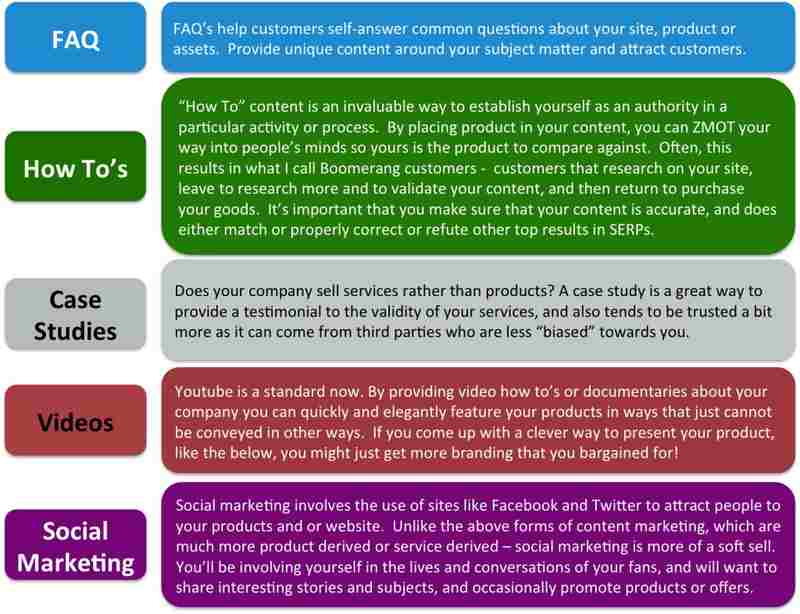Google quite clearly has stepped in and indicated that quality content is where it’s at. With the Panda and Penguin algorithm updates, Google clearly dropped the katana on what they see as trickery. So what will it take to excel in 2013? What will it take to get that ever elusive traffic to your website, so that you can turn those clicks into cash? There is no magic formula and you are going to have to put in the time, effort and understanding for your clients and your companies to understand what their customers want. In this article, I am going to address the nuts and bolts of what can be done to increase exposure to their websites. I am not going to discuss the more advanced methods of content marketing like viral videos, infographics or other methods that work on zeitgeist. To that effect, I am going to list some simple questions that I address when creating content for the sites that I manage.
- Why are people coming to your site?
- What are the steps to developing content?
- What are the basic questions your content should answer?
- What to do while you are waiting?
- What to do if you see no effect or results?
Content marketing helped grow traffic by 36%
But first, the results. If I am going to propose some kind of theoretical solution to your content marketing needs, shouldn’t I also provide some proof that the results are worth the effort? And so I shall! In 2012, I initiated just such an initiative in reaction to Panda and Penguin, and the results have been stunning.
As you can see, traffic is up over 36%. We are seeing some drop off in pages/visit and average visit duration but we understand that as we gather new traffic, we might not get traffic that is as focused as that of our earlier customers. Overall, the number that matters for me is that our e-commerce sales year-on-year so far for 2013 are up over 44%, and we continue to lead into this as the year develops. Remember, Google Analytics is a good tracking tool, but you also have to weigh that with real world results. I could be incredibly happy with a 36% increase in traffic, but that would not mean much to my CEO or myself if sales were not rising as well!
Why are people coming to your site?
The first question I ask when I look at a site, and at individual pages is, “What is a visitor looking for, on this site or page”. In my career in ecommerce, the answer to that has always been - customers who have been looking for products. And often, based on the phone calls that our customer service group gets, these customers are asking questions about the products, the fit, the purpose, and if they are getting ready to purchase the right item for the job. Great content is content that trains customers on product, educates them on features, and answers core questions about what products do. And I am not talking just on the product pages, I am talking about content on the category pages, and the main subject pages of the site. A good example of this is from when I worked at Harbor Freight Tools, we designed a section of the website to answer the question of what is the difference between an oil-less compressor and an oil compressor. Turns out, it’s fairly important as most artists who use airbrushes do not want oil from the compressed air mixing with their paints! So take time on your website pages, and look at them carefully. When a customer is navigating a page, what questions are they going to have? Once you know that, write content on that page to answer those questions.
Pay attention to these content types
Common types of content that can be generated depending on your industry:
What are the steps to developing content?
Let’s build out an outline of how to start developing content from the beginning:
- Choose pages
- Choose subjects
- Choose keywords
- Produce and post your content

Choose Pages
Take a look at Google Analytics content section, and locate 5 pages with moderate to high traffic that have little or no content. These will be the pages that we will experiment with over the next 2 months.
Choose Subjects
For each of the 5 pages that you have chosen, pull out a piece of paper and document what you think are the main questions that your visitors will be asking on these pages. Visit your customer service department and ask them the very same questions about those 5 pages. Pull all of that information together to generate idea on what type of content to develop such as FAQ, How To or a Case Study.
Choose Keywords
Now, you could use Google Analytics to find keywords related to the pages that you have chosen. Find a few keywords that are ranked below 10th position, and still have some impressions or clicks related to them. You’ll want to choose 2-3 keywords. Of these 2-3 keywords, choose 1 main keyword. When you design your content, make sure to use the main keyword several times - two or three times should be fine. Now, include it in a link to an appropriate sub-page. For the other keywords, use them once or twice. If your content is under 200 words, write more. You should be looking for 400-1000 words of good content addressing the subjects that you have discovered above. Once you have a total of 10 to 15 keywords, create a keyword group in BrightEdge, and start tracking those keywords.
Post Content
Once you have produced your content, post the content on the appropriate pages, and over the next 2-3 months, watch your rankings in BrightEdge. If you have produced quality content that visitors find interesting, you should see a very positive effect on your rankings and traffic. Additionally, you should see much more activity around the pages whose content has been increased.
What are the basic questions your content should answer?
Content that you develop should answer the following questions:
- Who am I (might be answered by simply being on your website)?
- What do I do (again, might be answered by simply being on your website)?
- What features do I offer?
- What is the value proposition?
- Is it unique content (not spun or copied from manufacturers or other websites)?
What to do while you are waiting?
They say that no good deed goes unpunished. And the price for writing quality content that generates traffic, is writing more quality content that generates more quality traffic. As you wait for your prior posts to show activity, you'll want to be writing more content that your customers demand - and placing it on your website in locations that are related to the content subject matter.
What to do if you see no effect or results?
After a period of time, you know that Google has crawled your site, and you know that you should be seeing an effect. If the results don't look good, you have a few places to look - and you can use the formula below to decide what to do: RANK = QUALITY x RECENCY x RELEVANCE x ORIGINALITY First, decide which of the above signals you need to affect. It could be one, two or all of them.
Originality
Did you just copy your content from elsewhere, and you have duplicate content from your own site, or another website? This is an easy fix, update the post, and write your own content.
Relevance
Are you trying to rank for a keyword that really is not relevant to the page, area or website that you are on? Take some time, and review what you are trying to do, and either move the content to a more relevant section, post links on other pages to this page reinforcing the relevance, or change your keyword targets.
Recency
Is the content you posted, old? It might be time for a re-write.
Quality
Are people coming to your content and leaving (Bounce), or are they only spending a short amount of time on the content (much less than the average of your site)? If so, you may need to re-evaluate the content, the subject matter, and start working to discover if you have the right content in the right place. I hope that this article has shed some light on how to choose subjects for content marketing, and what you can do to affect your website’s traffic. It's about consistent delivery of quality content that is relevant to your audience and that is original and new. With these very few basics, over time, you will win your position to more traffic for your website. Please write me (Kevin Hill) and share with me the results of your very own experiments!


